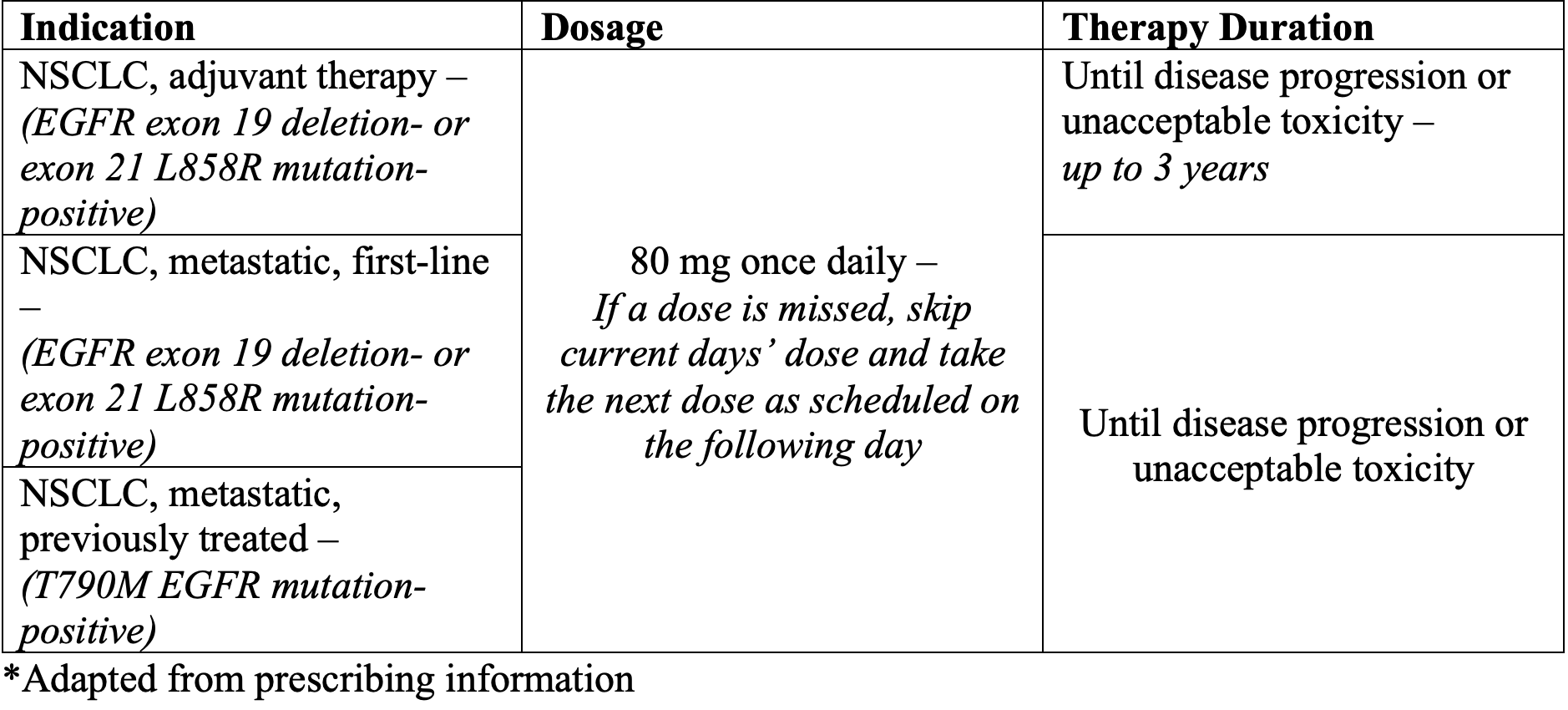Article
Oncology Overview: Discovering the Therapeutic Value of Osimertinib Targeted Therapy
Author(s):
Osimertinib (Tagrisso; AstraZeneca) is FDA approved for 3 unique cancer indications.
Osimertinib (Tagrisso; AstraZeneca) is an oral, targeted therapy approved by the FDA for 3 cancer indications,1 with the most recent approval for use as adjuvant therapy for non-small cell lung cancer (NSCLC) with epidermal growth factor receptor (EGFR) mutations.2 Lung cancer is currently the leading cause of cancer-related death worldwide, with an estimated 1.8 million deaths in 2020 and more than 2.2 million newly diagnosed cases.3 Osimertinib therapy may assist patients with lung cancer.
Indications
The FDA granted accelerated approval for osimertinib on November 16, 2015, for patients with metastatic EGFR T790M mutation-positive NSCLC, as detected by an FDA-approved test, whose disease has progressed on or after EGFR tyrosine kinase inhibitor (TKI) therapy.4 The FDA granted osimertinib full approval on March 30, 2017.5
Full FDA approval was based on the phase 3 AURA3 trial (NCT012151981), which showcased that in patients with prior radiotherapy within 6 months (n=23), overall response rate (ORR) was 64% with osimertinib and 22% with platinum-pemetrexed. ORR among patients without prior radiotherapy or radiotherapy greater than 6 months prior to randomization (n=93) was 21% and 5%, respectively. Additionally, an improvement in investigator-assessed progression-free survival was observed ([HR], 0.30; 95% [CI], 0.23-0.41; P = 0.001).5
Additional cancers treated by osimertinib include the following:
- Early stage NSCLC, adjuvant treatment, EGFR exon 19 deletions or exon 21 L858R mutations.2
- As detected in tumor specimen by an approved test.
- Metastatic NSCLC, EGFR exon 19 deletions or exon 21 L858R mutations.6
- As detected in tumor or plasma specimen by an approved test.
Mechanism of Action
Osimertinib is a TKI of the EGFR domain that binds irreversibly to specific forms of EGFR mutants (T790M, L858R, and exon 19 deletions) at roughly 9 times greater relative ligand potency than wild type. This selectively inhibits EGFR-meditated uncontrolled growth of cancer cells and cell signaling, consequently decreasing tumor growth and spread.
Dosage and Administration
Osimertinib is dosed as an 80 mg oral tablet, taken with or without food, for patients with select EGFR mutations.1
When osimertinib is concomitantly taken with strong CYP3A4 inducers, the labeling recommends increasing the dosage to 160 mg daily for all FDA-approved indications and to resume to the original 80 mg daily only after a 3-week washout from the strong CYP3A4 inducer has occurred.1
Table 1. Osimertinib Dosing1

Warnings, Precautions, and Patient Counseling Points
Osimertinib can cause severe, life threatening complications involving lung inflammation, fatal arrhythmias, serious rashes, and fulminant diarrhea. Osimertinib can be associated with leukopenia, lymphopenia, thrombocytopenia, diarrhea, anemia, rash, musculoskeletal pain, nail toxicity, neutropenia, dry skin, stomatitis, fatigue, and cough.1
It is essential that pharmacists monitor and educate their patients about osimertinib’s drug-related risks and adverse effects (AEs), especially any dermatological AEs, such as rash, because this can progress very rapidly with no recourse.
In the presence of AEs, pharmacists suggest treatment modifications to ensure patient safety (see Table 2).
Table 2.: Dosage Modifications for Osimertinib1

Pregnancy and Lactation
No data are available on osimertinib use in pregnant women; however, animal models suggest that molecules targeting the EGFRs, such as osimertinib, are expected to cause fetal harm.
Inform women of reproductive potential of the possible risk of fetal harm.1 Instruct female patients to notify their health care providers of a known or suspected pregnancy and to use effective contraception during osimertinib treatment and for 6 weeks after the last dose.
Male patients with female partners should use effective contraception during osimertinib treatment and for 16 weeks after the last dose.1
Definitive data on whether osimertinib can cross into breast milk or its potential for unintended effects on the child are lacking. Because of the risk of severe AEs in the nursing infant, female patients should be counseled to avoid breastfeeding during treatment and for 2 weeks after the last dose.1
About the Author
Robert Mownn, PharmD, is a pharmacist and the Sterile Products Coordinator at St. Vincent’s Medical Center in Connecticut
References
- Osimertinib. Prescribing information. AstraZeneca; 2021. Accessed December 20, 2021. https://den8dhaj6zs0e.cloudfront.net/50fd68b9-106b-4550-b5d0-12b045f8b184/52503580-1192-44f7-a05e-5743159ed19b/52503580-1192-44f7-a05e-5743159ed19b_viewable_rendition__v.pdf
- FDA approves osimertinib as adjuvant therapy for non-small cell lung cancer with EGFR mutations [News release]. FDA. May 29, 2020. Accessed December 20, 2021. https://www.fda.gov/drugs/resources-information-approved-drugs/fda-approves-osimertinib-adjuvant-therapy-non-small-cell-lung-cancer-egfr-mutations
- Sung, H, Ferlay, J, Siegel, RL, et al. Global cancer statistics 2020: GLOBOCAN estimates of incidence and mortality worldwide for 36 cancers in 185 countries. CA Cancer J Clin. 2021;71: 209-249. https://doi.org/10.3322/caac.21660
- TAGRISSO™ (AZD9291) approved by the US FDA for patients with EGFR T790M mutation-positive metastatic non-small cell lung cancer [News release] AstraZeneca. Novemeber 13, 2015. Accessed December 20, 2021. https://www.astrazeneca.com/media-centre/press-releases/2015/TAGRISSO-AZD9291-approved-by-the-US-FDA-for-patients-with-EGFR-T790M-mutation-positive-metastatic-non-small-cell-lung-cancer-13112015.html#!
- Osimertinib (TAGRISSO) [New release]. FDA. March 30, 2017. Accessed December 20, 2021. https://www.fda.gov/drugs/resources-information-approved-drugs/osimertinib-tagrisso
- FDA approves osimertinib for first-line treatment of metastatic NSCLC with most common EGFR mutations [News release]. FDA. April 18, 2018. Accessed December 20, 2021. https://www.fda.gov/drugs/resources-information-approved-drugs/fda-approves-osimertinib-first-line-treatment-metastatic-nsclc-most-common-egfr-mutations






